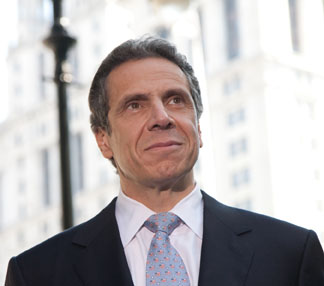 Setting New York”™s economic development agenda in 2013, Gov. Andrew M. Cuomo in his State of the State Address said the state will build upon the work of its 2-year-old regional economic development councils and partnerships with higher education to promote technology transfer into the marketplace and innovative enterprises financed in part by a new $50 million venture capital fund.
Setting New York”™s economic development agenda in 2013, Gov. Andrew M. Cuomo in his State of the State Address said the state will build upon the work of its 2-year-old regional economic development councils and partnerships with higher education to promote technology transfer into the marketplace and innovative enterprises financed in part by a new $50 million venture capital fund.
The governor also proposed reforms to the state”™s unemployment insurance and workers”™ compensation programs that he said will save businesses $1.3 billion while increasing jobless benefits to workers for the first time in 14 years.
In a proposal likely to be opposed by some business groups, Cuomo said he would seek a $1.50 hike in the state”™s hourly minimum wage, from $7.25 to $8.75 per hour.
The governor in his annual address also said he will use the state”™s 10 regional economic development councils to advance an “opportunity agenda” to bring poor communities more fully into New York”™s economic revitalization effort. Each council will focus on one distressed community in its region and develop strategies that address the challenges of poverty and then enable the community to compete for state funding.
Noting that many of the country”™s major high-tech economic clusters owe their success to technology transfer, the governor proposed several steps to accelerate the commercialization of ideas developed in academia and create new businesses to take them to market. They include:
Innovation Hot Spots: In a competitive process, 10 high-tech incubators run by universities and the private sector will be selected as “hot spots,” tax-free zones where inventors and entrepreneurs will receive support to grow their businesses.
Innovation NY Network: To break down barriers to commercialization, the network will build collaboration among academics, venture capitalists, business leaders, patent lawyers and other professionals and entrepreneurs.
Innovation Venture Capital Fund: A $50 million venture capital fund will provide incentives for successful startups to stay and grow in New York.
To make New York a national leader in building a clean tech economy program, Cuomo announced these steps:
NY Green Bank: The $1 billion fund will leverage public dollars with private sector matches to spur the clean economy.
Extend NY-Sun Solar Jobs: The program will be expanded to $150 million annually for 10 years to increase solar panel installations for homes and businesses.
Charge NY Program: The program will invest in an electric car network to reduce reliance on fossil fuels by installing a statewide network of charging stations and providing tax credits to build network infrastructure.
Cabinet-Level Energy Czar: Richard Kauffman, a senior adviser to U.S. Secretary of Energy Steven Chu, will coordinate the state”™s clean tech agenda and oversee the state government”™s energy portfolio.
To retool New York”™s workforce, Cuomo proposed steps to “reimagine” the SUNY and CUNY community colleges to ensure the state”™s job training programs produce the trained personnel that businesses need. His proposed Next Generation Job Linkage Program will connect community colleges with employers to identify the job, define the skill and provide the training for it. The state will offer performance pay by funding colleges based on student job placement.
To boost economic development upstate, the governor unveiled plans for Market NY, a new multifaceted marketing plan. It includes:
Taste-NY: The initiative will promote New York products, including creating duty-free “Taste-NY” stores across the state to market products grown and produced here.
Advertising Competition: A new $5 million advertising competition for the best regional marketing plans will be an incentive for counties to work together to forge “regional synergies.”
The Adirondack Challenge: Noting that New York has some of the best whitewater rafting in the nation, Cuomo proposed a national whitewater rafting competition in the North Country.
Destination Resorts and Casino Gaming: To increase upstate tourism, up to three casinos would be built in upstate communities. Cuomo proposed to allocate 90 percent of casino gaming revenue for education and 10 percent for municipal property tax relief.
The casino proposal will require a voter referendum.
“New York is on its way, coming back stronger than ever before, rising to meet some of the biggest challenges in our history, remaining as a progressive beacon of light to the rest of the nation, and standing out as a model of effective government,” Cuomo said in his address. “Gone are the anti-business, obstructionist, tax capital, and gridlock mentalities, replaced with an entrepreneurial government that collaboratively works together for the people and partners with the private sector to create jobs and get the economy back on track.”
















